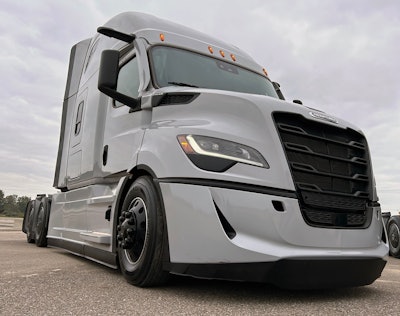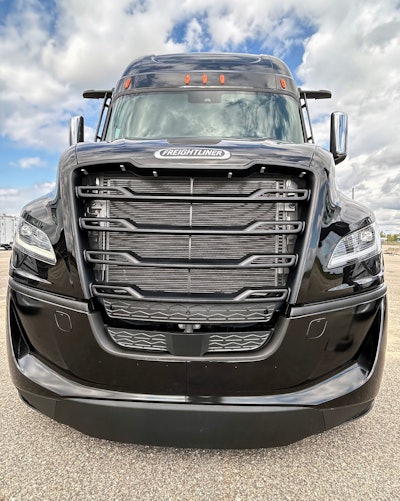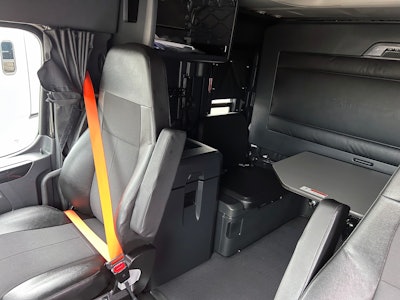 The Gen5 Cascadia gets a new hood and grille design, a redesigned A-pillar deflector, three-piece front wheel well closeouts, a hood-to-bumper seal, and new bumper air ducts along with factory-fit mirror camera system.
The Gen5 Cascadia gets a new hood and grille design, a redesigned A-pillar deflector, three-piece front wheel well closeouts, a hood-to-bumper seal, and new bumper air ducts along with factory-fit mirror camera system.
Since its 2007 debut, Freightliner has retailed more than 1 million of its Cascadia flagship on-highway tractors, propelling the company to a leading 40%-plus marketshare. Monday night, Portland-based Daimler Truck North America (DTNA) unveiled the tech-heavy fifth-generation model the company hopes will drive sales of millions more at a debut event that was capped by a performance from hair metal rockers Def Leppard.
Schneider was among the early adopters of Cascadia, a truck that now comprises 80%-plus of the company’s fleet. Crete Carrier Corporation has ordered close to 50,000 Cascadia, and 90% of its entire fleet is Freightliner. Yet despite its reputation as a fleet truck, DTNA General Manager of Product Strategy and Market Development Mary Aufdemberg noted Cascadia has consistently been winning over owner operators and small fleets “because fuel economy has started to be cool.”
Fuel economy is so cool, it was a major focus of the forthcoming next-generation tractor. Cascadia previously got its most recent update in 2018, and discussion on fifth-generation enhancements started almost immediately afterward. Greg Treinen, DTNA vice president of on-highway market development, said the company’s next-generation truck was designed around three pillars: safety, efficiency and profitability.
Safety
A new electrical architecture is “the backbone,” said Treinen, and facilitates the improvements and enhancements to the Detroit-powered safety system.
The fifth-generation Freightliner Cascadia ushers in new and expanded capabilities for the Detroit Assurance Suite of Safety Systems, including enhanced computing power and an upgraded camera, as well as four new short-range radar sensors and an improved long-range radar sensor.
Active Brake Assist 6 (ABA6) is now capable of seeing longer and wider and is able to recognize additional scenarios thanks to an all-new long range radar that’s been incorporated into the grille, four short-range sensors (two under the headlamps and two along the side fairings), and a camera tucked at the top of the windshield. The camera is also smaller than previous iterations, allowing Freightliner to shrink the housing and give the driver more visibility through the windshield.
The enhanced computing power makes the truck capable of automatic braking when it detects vehicles stopped at odd angles, vehicles in curves, stopped vehicles across multiple lanes, and it now recognizes both moving and stationary pedestrians in its path.
An all-new Intelligent Braking Control System (IBCS) for the Freightliner Cascadia introduces brake-by-wire technology with backup pneumatics and employs wheel speed sensors and a chassis-mounted electronic control unit to help provide advanced deceleration control. IBCS allows for the introduction of Comfort Braking, which provides brake force distribution, lining wear control and performance monitoring that ensure smoother, more confident braking (especially in sudden stops), and help extend brake pad life through even wear.
IBCS also includes Endurance Braking, a braking control feature that makes the braking experience easier for the driver by marrying the engine brake with the service brakes, also saving wear and tear.
And while we’re on brakes, Freightliner has added paddle-style air brake switches and rollaway protection. If the driver hops out of the driver’s seat while the truck is in gear, the system will automatically activate the electronic parking brake once it senses there’s no weight in the seat.
Active Lane Assist 2 (ALA2), in addition to previous capabilities, now features Lane Change Assist, which can help mitigate lane departure accidents by providing counter steer if the truck attempts to enter an occupied lane. When Lane Keep Assist is active, Attentive Driver Protection monitors the driver’s attention through steering wheel input and can initiate a routine sequence that keeps the Cascadia centered in its lane, slows the vehicle to a stop and turns on the hazard lights if the driver is unresponsive.
Side Guard Assist 2 (SGA2) is now capable of detecting and warning drivers of objects on the driver side as well as the passenger side of the vehicle, from the cab to the end of the trailer.
Scheduled to begin production mid-2025, the fifth-generation Freightliner Cascadia also offers a MirrorCam System. Cameras mounted above the doors provide a wide field of view alongside the rig and in the look-down blindspot and feed those visuals to the driver through three in-cab displays. The camera arm system has been modified from the prior aftermarket version and allows for breakaway forward and backward in the event of limb or debris strikes. The infrared lenses auto-adjust based on lighting conditions and feature a hydrophobic coating that repels water and contaminants.
“Now that they are a proprietary integrated system, we’re able to integrate the Side Guard Assist alerts into the monitors,” said Miranda Richardson, DTNA on-highway product marketing manager. “Should a vehicle be detected in one of your blindspots, the alert will pop up in the MirrorCam System as well.”
Located on both sides of the new grille and redesigned hood (more on those later) are new dual-stage LED headlamps that are 30% brighter than current generation LEDs. The lamps feature automatic deicing and defogging capabilities and auto bright and dim.
“They provide a 45-degree light pattern,” Richardson added. “It really helps the driver with visibility at night, and it also eliminates the need for fog lights.”
Efficiency
 Most of the obvious changes to the new Cascadia are found at the front: among them are a new grille, brighter LED headlamps and a more aerodynamic bumper.
Most of the obvious changes to the new Cascadia are found at the front: among them are a new grille, brighter LED headlamps and a more aerodynamic bumper.
Outside you’ll notice a new hood and grille design, a redesigned A-pillar deflector, three-piece front wheel well closeouts, a hood-to-bumper seal, and new bumper air ducts.
The air ducts in the two-piece bumper guide air around the truck and out through the wheel well. Wheel well closeouts have been added to the hood.
“Tires are a huge wake region, creating a lot of drag… [and] that’s a big place for drag that we’re really trying to eliminate,” Richardson said.
The air ducts also help cool the service brakes on the steer axle. The hood-to-bumper seal keeps air from getting under the hood.
Also available is an optional Max Aero Bumper, which brings even greater efficiency. It features a three-piece air dam that is a holdover from the prior generation Cascadia, but it’s been improved for better ground clearance.
Originally introduced on the current Cascadia, an A-pillar deflector was intended to reduce soiling of the window and mirrors. For the fifth-generation tractor, it’s been extended to cover more of the door profile, and it flairs out at the bottom to improve aerodynamics.
One of the most recognizable changes is the redesigned grille. Available in all-back or black with matte silver accents, it’s the same size as previous generations, features the same cooling capacity and is tucked into a restyled hood that, too, helps manage airflow.
Available at launch will be the Detroit DD13 and DD15 engines, with ratings of up to 505 horsepower and 1,850 lb-ft of torque. Roughly 95% of all new Cascadia are currently spec’d with Detroit engines, and about 90% of them get a DT12 transmission.
The Cummins X15 diesel is also available for 2025. The X15N natural gas engine will be available for Cascadia built in 2026. Cummins’ horsepower ratings are 400 to 605 hp with 1,450 to 2,050 lb-ft of torque. An EPA’27 compliant DD15 will be made available for the 2027 model year.
Profitability
Technology that keeps the business rolling is equally as important as the tech that moves the truck, so the fifth-generation update includes some dollars and cents upgrades, too.
“We are a technology company that delivers freight,” said Tonn Ostergard, chairman and CEO of Crete Carrier Corporation, adding that his company makes equipment decisions based on high uptime and “very low cost of ownership.”
Back office personnel also reap benefits from the updated Cascadia, primarily in improving uptime and improved operational insights through the newest connected telematics platform powering Detroit Connect.
Detroit Connect Video Capture 2.0 automatically records and captures data during safety events or when initiated by a driver, providing fleet managers with remote access to valuable insights on driver behavior and potential risks. The platform can store up to 30 hours of video, which are available in near-real-time through an improved user interface within the Detroit Connect Portal.
Remote Lock and Unlock is a new feature derived directly from fleet manager feedback and brings the ability to lock and unlock vehicles on demand, reducing roadside assistance costs.
Geofencing allows fleets to create custom-defined geographic areas in the Detroit Connect Portal and receive notifications when vehicles enter or leave that area.
Detroit Connect Safety Plus is a subscription service that allows fleet managers to remotely track and receive notifications about the status and health of Detroit Assurance safety systems.
Premium Remote Parameter Updates expands the number of parameters available for update over the air from seven to more than 50.
Where you won’t find many updates
 Citing an already best-in-class interior, Freightliner opted to focus most of its fifth generation updates elsewhere.
Citing an already best-in-class interior, Freightliner opted to focus most of its fifth generation updates elsewhere.
Very little, if anything at all, was changed inside the cab. Richardson noted that Freightliner took a priority approach to the things it wanted to address for the fifth generation truck, leaning into feedback from its customers. She said there wasn’t much intel from customers suggesting changes to the interior were needed, which allowed designers and engineers to focus on the items that drive operational efficiency.
“We feel like this was already the best and most premium cab in the industry,” she said.
A new intelligent air system, however, did allow designers to remove airlines from behind the dash.
The updates to the Gen5 Cascadia aren’t simply a facelift. There’s a lot going on in the backbone of the truck. yes, some of the new design elements are indeed subtle, but they aren’t jarring for Cascadia loyalists and that is important. Much like Def Leppard, whose career spans 47 years, 12 studio albums and induction into the Rock and Roll Hall of Fame, Freightliner had to make some tweaks between generations while also staying true to what they are at heart and deliver what the fans want.
Def Leppard has, to-date, sold more than 100 million records worldwide, and Cascadia is hot on their heels.